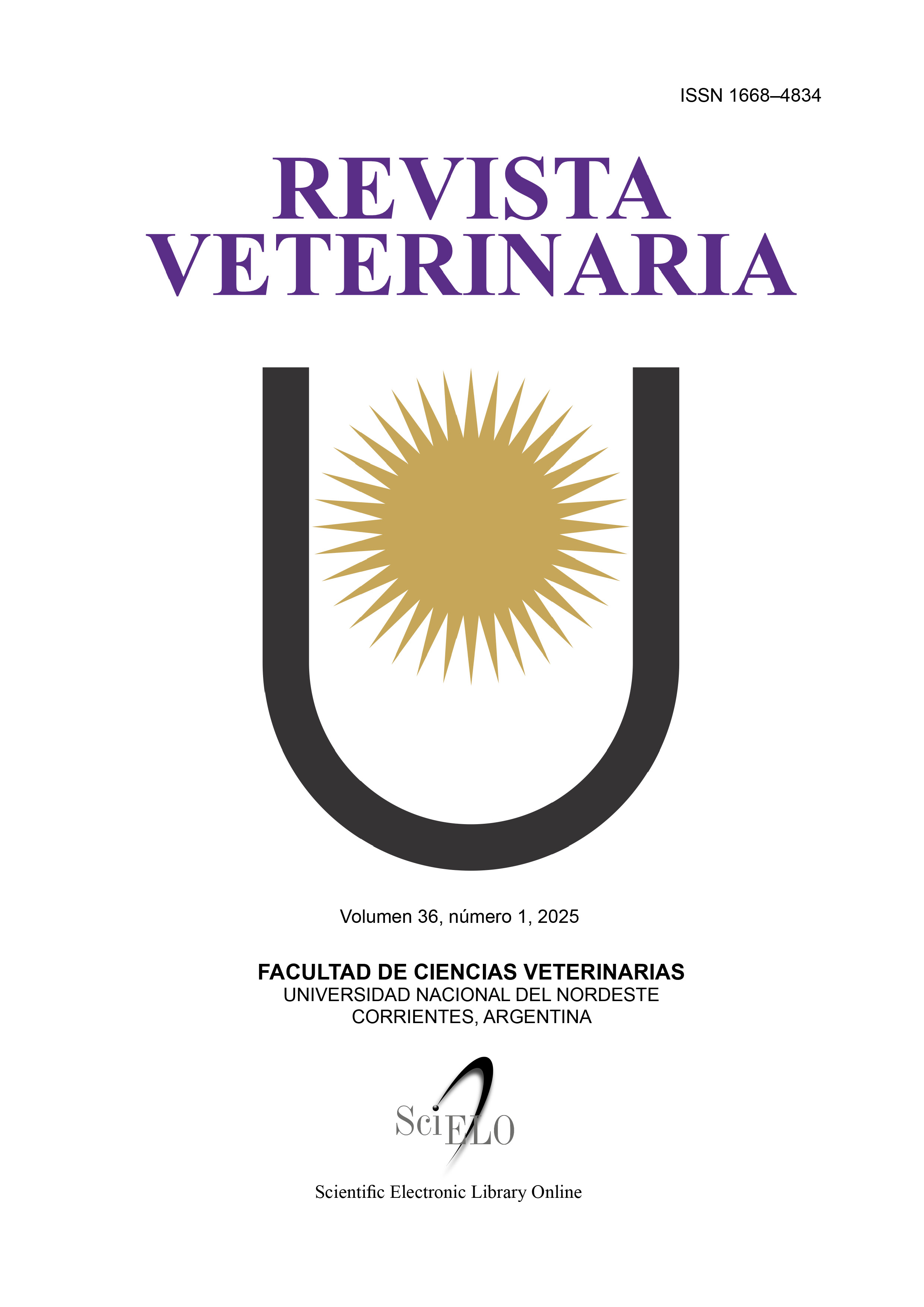Effect of the type of house on animal welfare indicators in hybrid chickens for meat
DOI:
https://doi.org/10.30972/vet.3617989Keywords:
poultry, housing, environment, summerAbstract
The poultry industry is one of the primary sources of animal protein, requiring advanced facilities and equipment. The objective of this study was to evaluate the animal welfare of chickens for meat raised in two types of sheds, using four animal-based indicators with an individual methodology. The trial was carried out in the northeastern region of Santa Fe province (Argentina) over two summer production cycles. Eight closed sheds with forced ventilation were tested, four blackout-type (Dark) sheds and four tunnel-type (Light) sheds, distributed across four grow-out farms. Between days 35 and 42 of the production cycle, 25 male and female Cobb 500® hybrid chickens, in five points of every sheds, were examined. The following welfare indicators were assessed: feather soiling (FS), footpad lesions (FPL), tarsal burn (TB) and gait (G), with severity scored according to the Welfare Quality® methodology. Statistically significant differences were observed between housing types across all four variables using a chi-square homogeneity test. In FS (p = 0.0103) and FPL (p<0.0001 higher proportions of feather soiling and footpad lesions were observed in the Light sheds, while in TB (p=0.0002) and G (p<0.0001), a higher percentage of affected chickens was found in the Dark sheds. The results indicate that, while the facilities provide adequate conditions for rearing, precise adjustments are still needed to optimize the interactions between environmental components and enhance animal welfare.
Downloads
References
Abeyesinghe SM, Chancellor NM, Moore DH, Chang YM, Pearce J, Demmers T, Nicol, CJ. Associations between behavior and health outcomes in conventional and slow-growing breeds of broiler chicken. Animal. 2021; 15(7): 100261.
Alvino GM, Archer GS, Mench JA. Behavioral time budgets of broiler chickens reared in varying light intensities. Appl Anim Behav Sci. 2009; 118(1-2): 54-61.
Amer MM. Footpad dermatitis (FPD) in chickens. The Korean Journal of Food & Health Convergence. 2020; 6(4): 11-16.
Broom DM. Indicators of poor welfare. Br Vet J. 1986; 142: 524-526.
Broom DM. Animal welfare: concepts, study methods and indicators. Rev Colomb Cienc Pec. 2011; 24(3): 306-321.
Butterworth A. Welfare assessment of poultry on farm. In Advances in poultry welfare. 2018; 113-130.
Camacho Chacón J, Castro Murillo M, Reyes Moreno LL. La ciencia del bienestar animal: conceptualización y discusión. Revista De Filosofía De La Universidad De Costa Rica. 2019; 58(150-151): 89-98.
Daghir NJ. Poultry production in hot climates. 2008. Cabi. (Ed.). ISBN: 978-1-84593-417-0, 375 p.
Davis NJ, Prescott NB, Savory CJ, Wathes CM. Preferences of growing fowls for different light intensities in relation to age, strain and behavior. Anim. Welf. 1999; 8(3): 193-203.
de Jong IC, Hindle VA, Butterworth A, Engel B, Ferrari P, Gunnink H, Pérez Moya T, Familia Tuyttens, van Reenen CG. Simplifying the Welfare Quality® assessment protocol for broiler chicken welfare. Animal. 2016; 10(1): 117-127.
Donald J. Manejo del ambiente en el galpón de pollo de engorde. Aviagen Incorporated; 2009. Recuperado de https://es.aviagen.com/assets/Tech_Center/BB_Foreign_Language_Docs/Spanish_TechDocs/Aviagen-Manejo-Ambiente-Galpn-Pollo-Engorde-2009.pdf
EFSA AHAW Panel (EFSA Panel on Animal Health and Welfare), Nielsen, SS, Alvarez, J, Bicout, DJ, Calistri, P, Canali, E, Michel, V. Welfare of broilers on farm. EFSA Journal. 2023; 21(2): e07788.
Freeman N, Tuyttens FA, Johnson A, Marshall V, Garmyn A, Jacobs L. Remedying contact dermatitis in broiler chickens with novel flooring treatments. Animals. 2020; 10(10): 1761.
García RG, Lima NDD S, Naas IDA, Caldara FR, Sgavioli S. The typology of broiler house and the impact in the locomotion of broilers. Engen. Agríc. 2018; 38: 326-333.
Granquist EG, Vasdal G, De Jong IC, Moe RO. Lameness and its relationship with health and production measures in broiler chickens. Animals, 2019; 13(10): 2365-2372.
Gomes De Oliveira R, José Camargos Lara L. Lighting programmes and its implications for broiler chickens. Worlds Poult Sci J. 2016; 72(4): 735-742.
Hofmann T, Schmucker SS, Bessei W, Grashorn M, Stefanski V. Impact of housing environment on the immune system in chickens: A review. Animals. 2020; 10(7): 1138.
INET. MINAGRI. Sector avícola. Informe final preliminar. 2010. Disponible en: http://catalogo.inet.edu.ar/files/pdfs/info_sectorial/avicola-informe-sectorial.pdf
Kang SW, Christensen KD, Kidd Jr MT, Orlowski SK, Clark J. Effects of a variable light intensity lighting program on the welfare and performance of commercial broiler chickens. Front. Physiol. 2023; 14: 1059055.
Kim HJ, Son J, Jeon JJ, Kim HS, Yun YS, Kang HK, Kim JH. Effects of photoperiod on the performance, blood profile, welfare parameters, and carcass characteristics in broiler chickens. Animals. 2022; 12(17): 2290.
Kwon BY, Park J, Kim DH, Lee KW. Assessment of Welfare Problems in Broilers: Focus on Musculoskeletal Problems Associated with Their Rapid Growth. Animals, 2024; 14(7): 1116.
Kwon BY, Lee HG, Jeon YS, Song JY, Kim SH, Ki, DW, Lee KW. Research Note: Welfare and stress responses of broiler chickens raised in conventional and animal welfare-certified broiler farms. Poult Sci, 2024; 103(3): 103402.
Liu KL, He YF, Xu BW, Lin LX, Chen P, Iqbal MK, Huang SC. Leg disorders in broiler chickens: a review of current knowledge. Anim. biotechnol. 2023; 34(9): 5124-5138.
Louton H, Bergmann S, Reese S, Erhard M, Bachmeier J, Rösler B, Rauch E. Animal-and management-based welfare indicators for a conventional broiler strain in 2 barn types (Louisiana barn and closed barn). Poult Sci, 2018; 97(8): 2754-2767.
MacDonald JM. Technology, organization, and financial performance in US broiler production. Bulletin Number 126; 2014. United States Department of Agriculture. Economic Information. Disponible en: https://www.ers.usda.gov/webdocs/publications/43869/48159_eib126.pdf?v=8437
Manser CE. Effects of lighting on the welfare of domestic poultry: a review. Anim. Welf. 1996; 5(4): 341-360.
Marchewka J, Watanabe TTN, Ferrante V, Estevez I. Welfare assessment in broiler farms: Transect walks versus individual scoring. Poult Sci. 2013; 92(10): 2588-2599.
Meluzzi A, Fabbri C, Folegatti E, Sirri F. Effect of less intensive rearing conditions on litter characteristics, growth performance, carcass injuries and meat quality of broilers. Br. Poult. Sci. 2008; 49(5): 509-515.
Ministerio de economía, Dirección de Porcinos, Aves y Animales de Granja, equipo Técnico área avícola. Pollos Parrilleros. Relevamiento Integral de Granjas. Informe 2019. https://www.magyp.gob.ar/sitio/areas/aves/encuesta/_archivos//230615_Informe%20Relevamiento%20Integral%20Granjas%20Pollos%20Parrilleros.pdf
Munir MT, Belloncle C, Irle M, Federighi M. Wood-based litter in poultry production: a review. Worlds Poult Sci J. 2019; 75(1): 5-16.
Prescott NB, Wathes CM. Reflective properties of domestic fowl (Gallus g. domesticus), the fabric of their housing and the characteristics of the light environment in environmentally controlled poultry houses. Br. Poult. Sci. 1999; 40(2): 185-193.
Rault JL, Clark K, Groves PJ, Cronin GM. Light intensity of 5 or 20 lux on broiler behavior, welfare and productivity. Poult Sci. 2017; 96(4): 779-787.
Rovers A, Christoph‐Schulz I, Brümmer N. Citizens’ perception of different aspects regarding German livestock production. Int. J. Food Syst. Dyn. 2019; 10(4): 361-374.
Sans ECO, Vale MM, Vieira FMC, Vismara ES, Molento CFM. In-barn heterogeneity of broiler chicken welfare in two industrial house designs and two seasons in Southern Brazilian subtropical climate. Livest. Scie. 2021; 250: 104569.
Saraiva S, Saraiva C, Stilwell G. Feather conditions and clinical scores as indicators of broilers welfare at the slaughterhouse. Res Vet Sci. 2016; 107: 75-79.
Szőllősi L, Béres E, Szűcs I. Effects of modern technology on broiler chicken performance and economic indicators–a Hungarian case study. Ital. J. Anim. Sci., 2021; 20(1): 188-194.
Tallentire CW, Leinonen I, Kyriazakis I. Breeding for efficiency in the broiler chicken: A review. Agron Sustain Dev. 2016; 36: 1-16.
Tavárez MA, Solis de los Santos F. Impact of genetics and breeding on broiler production performance: a look into the past, present, and future of the industry. Animal Front., 2016; 6(4): 37-41.
Tullo E, Fontana I, Peña Fernandez A, Vranken E, Norton T, Berckmans D, Guarino M. Association between environmental predisposing risk factors and leg disorders in broiler chickens. J. Anim. Sci. 2017; 95(4): 1512-1520.
Welfare Quality Assessment Protocols for Poultry (Broilers, Laying Hens). 2009. Welfare Quality Consortium, Lelystad, The Netherlands.
Wilcox CH, Sandilands V, Mayasari N, Asmara IY, Anang A. A literature review of broiler chicken welfare, husbandry, and assessment. Worlds Poult Sci J. 2024; 80(1): 3-32.
Downloads
Published
How to Cite
Issue
Section
License

This work is licensed under a Creative Commons Attribution-NonCommercial 4.0 International License.
Revista Veterinaria (Rev. Vet.) maintains a commitment to the policies of Open Access to scientific information, as it considers that both scientific publications as well as research investigations funded by public resources should circulate freely without restrictions. Revista Veterinaria (Rev. Vet.) ratifies the Open Access model in which scientific publications are made freely available at no cost online.










.jpg)
.jpg)



